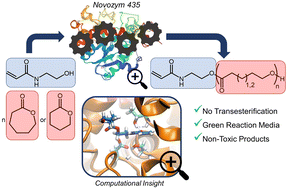N-Hydroxyethyl acrylamide as a functional eROP initiator for the preparation of nanoparticles under “greener” reaction conditions†
Abstract
N-Hydroxyethyl acrylamide was used as a functional initiator for the enzymatic ring-opening polymerisation of ε-caprolactone and δ-valerolactone. N-Hydroxyethyl acrylamide was found not to undergo self-reaction in the presence of Lipase B from Candida antarctica under the reaction conditions employed. By contrast, this is a major problem for 2-hydroxyethyl methacrylate and 2-hydroxyethyl acrylate which both show significant transesterification issues leading to unwanted branching and cross-linking. Surprisingly, N-hydroxyethyl acrylamide did not react fully during enzymatic ring-opening polymerisation. Computational docking studies helped us understand that the initiated polymer chains have a higher affinity for the enzyme active site than the initiator alone, leading to polymer propagation proceeding at a faster rate than polymer initiation leading to incomplete initiator consumption. Hydroxyl end group fidelity was confirmed by organocatalytic chain extension with lactide. N-Hydroxyethyl acrylamide initiated polycaprolactones were free-radical copolymerised with PEGMA to produce a small set of amphiphilic copolymers. The amphiphilic polymers were shown to self-assemble into nanoparticles, and to display low cytotoxicity in 2D in vitro experiments. To increase the green credentials of the synthetic strategies, all reactions were carried out in 2-methyl tetrahydrofuran, a solvent derived from renewable resources and an alternative for the more traditionally used fossil-based solvents tetrahydrofuran, dichloromethane, and toluene.



 Please wait while we load your content...
Please wait while we load your content...